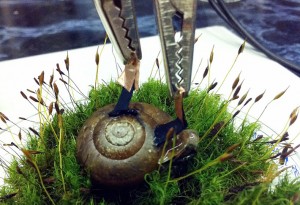 Bioengineers are getting better at replacing and enhancing body parts, but so far they’ve struggled to power implantable bionics without resorting to clunky batteries. But because blood carries energy in the form of electron-rich molecules like glucose and delivers it to all parts of the body, it is a tempting target for researchers. Chemist Evgeny Katz of Clarkson University, in Potsdam, N.Y., and his colleagues recently tested a new kind of electrode, which, when implanted in Neohelix albolabris snails and immersed in the snails’ blue, bloodlike hemolymph, produced a small, steady supply of electricity over a period of months. The researchers reported the work in March in the Journal of the American Chemical Society.The group built a small fuel cell to tap the energy in the oxygen and glucose molecules dissolved in the snails’ hemolymph. They started by coating the anode with an enzyme that goes by the graceful name of pyrroloquinoline quinone-dependent glucose dehydrogenase (PQQ-GDH). That enzyme pulls electrons from glucose molecules. The researchers then coated the cathode with a plant enzyme, laccase, which pushes electrons onto oxygen molecules. When immersed in hemolymph, the electrodes delivered a measurable current.;
Bioengineers are getting better at replacing and enhancing body parts, but so far they’ve struggled to power implantable bionics without resorting to clunky batteries. But because blood carries energy in the form of electron-rich molecules like glucose and delivers it to all parts of the body, it is a tempting target for researchers. Chemist Evgeny Katz of Clarkson University, in Potsdam, N.Y., and his colleagues recently tested a new kind of electrode, which, when implanted in Neohelix albolabris snails and immersed in the snails’ blue, bloodlike hemolymph, produced a small, steady supply of electricity over a period of months. The researchers reported the work in March in the Journal of the American Chemical Society.The group built a small fuel cell to tap the energy in the oxygen and glucose molecules dissolved in the snails’ hemolymph. They started by coating the anode with an enzyme that goes by the graceful name of pyrroloquinoline quinone-dependent glucose dehydrogenase (PQQ-GDH). That enzyme pulls electrons from glucose molecules. The researchers then coated the cathode with a plant enzyme, laccase, which pushes electrons onto oxygen molecules. When immersed in hemolymph, the electrodes delivered a measurable current.;
Choosing the right material for the electrodes is important because the intermediate enzymes usually interact little with electrodes, Katz explains. His team used buckypaper, a rough, 3-D structure built of tiny conducting carbon nanotubes. “Buckypaper electrodes are very practical,” says biochemical engineer Sven Kerzenmacher at the University of Freiburg, in Germany, who was not involved with Katz’s team but is also experimenting with buckypaper electrodes for biological energy harvesting. The nanomaterial exposes more of the electrode to electron-bearing molecules in the snail’s hemolymph than other electrode materials would.
In the snails Katz studied, the electrodes extracted as much as 7.45 microwatts in a 20-minute burst and sustained 0.16 μW for up to an hour. Researchers at Case Western Reserve University, in Cleveland, recently implanted similar biofuel cells in cockroaches, extracting slightly less power.
A modern human pacemaker typically requires a steady supply of around 1 μW by comparison. But the smaller dribbles of power scavenged from snails or other small creatures could be useful for things other than implanted medical devices: Snails, cockroaches, or other creatures could infiltrate hard-to-reach places wearing sensors and send reports via wireless transmitters. The sensor-equipped animals could serve as unobtrusive spies or help emergency-relief teams explore damaged buildings. While batteries could power such missions, they require a lot of bulk relative to the energy they provide; tapping a tiny animal’s blood would be more efficient.
In related research, other scientists are working on energy harvesters that could be powered by human blood instead of hemolymph. There are important differences: Human blood is better than snail hemolymph at distributing glucose, but most oxygen in human blood is trapped in hemoglobin, and a cathode needs free dissolved oxygen to work. Humans also have strong immune systems that attack foreign bodies and coagulants that could clot up microturbines and other mechanical energy harvesters.
Biomedical engineer Philippe Cinquin of Joseph Fourier University in Grenoble, France, has tested his glucose biofuel cells for a period of 40 days in living rats, but, unlike with the Potsdam team’s snail experiments, he had to build membranes to keep some biochemicals away from his electrodes. “Long-term biocompatibility is the major point we have to work on,” Cinquin says.
An initial application for human biofuel cells could be to power short-term implants, such as blood glucose sensors for diabetes, says Kerzenmacher. In such cases, long-term biocompatibility is less important, and the efficiency of the electrodes, which normally degrade over time, matters less. But once long-term, implantable electricity harvesters are available, they could enable tiny distributed devices to stimulate nerves and alleviate chronic pain, researchers say. Users of cochlear implants, for example, would also benefit from an independent power supply, according to Cinquin. “There are a lot more biomedical devices we could build if we know we have energy for them,” he says.
See this news story as it appeared on IEEE Spectrum’s website: [html] or as it appeared in the May print issue: [pdf]